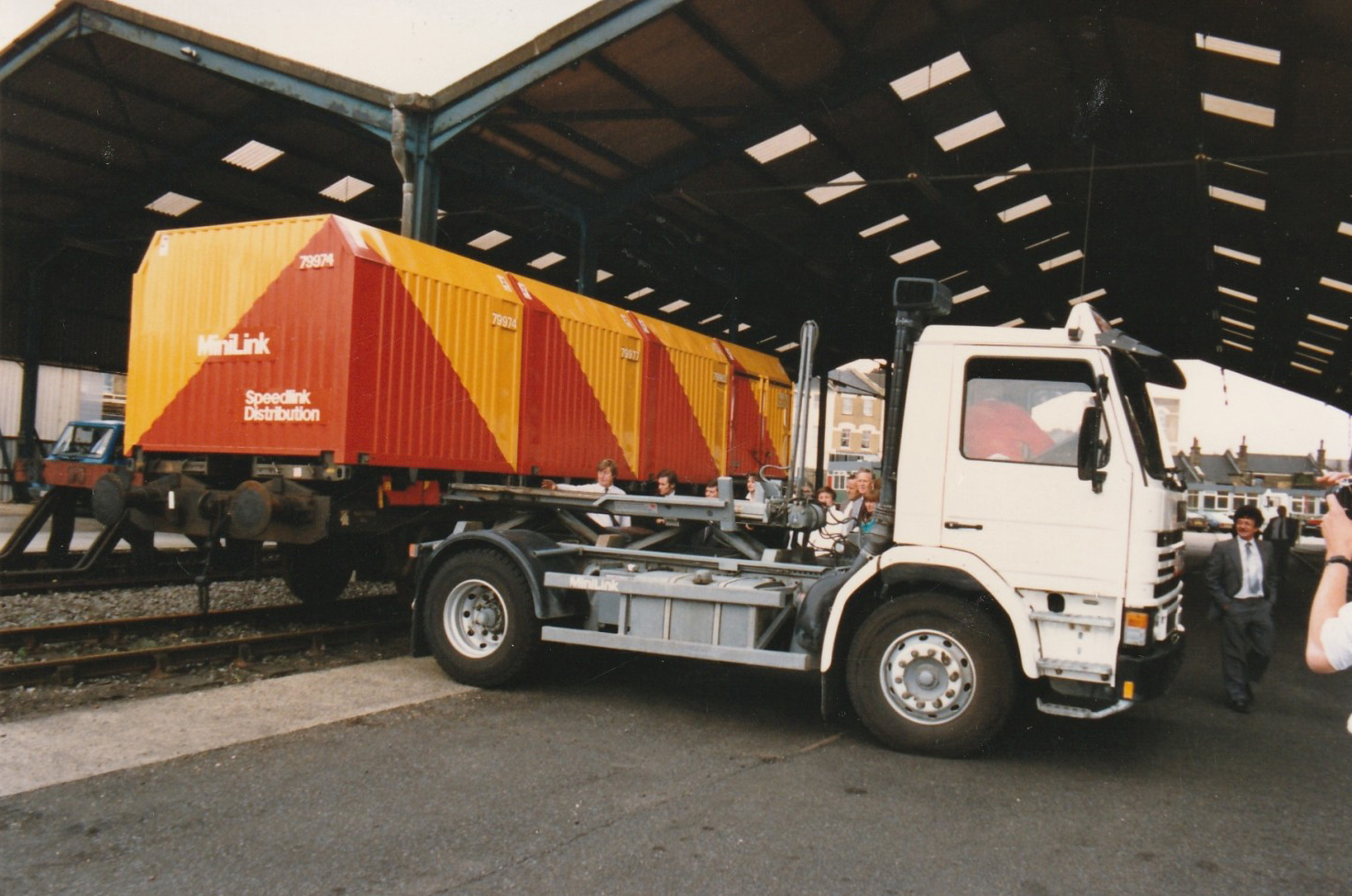Minilink was a small container system based on technology developed by Kalmar Lagab of Sweden which was in use in Scandinavia in the early 1980s. In the late 1980s British Rail’s Speedlink business decided to invest in a trial operation between London and Glasgow.
In my view, the system was technically neat. The transport unit was a roughly cubic metal container. One container fitted nicely onto a small flatbed rigid road goods vehicle and 4-5 containers could fit onto a 2 axle flat bed rail wagon. Both the wagon and the road vehicle were fitted with frames to hold the containers and to transfer them. Transfer from road to rail was simple: the lorry would reverse up to the wagon at right angles and a mechanism on the truck would push the frame across to engage with the frame on the wagon. The container was then pushed across onto the wagon. This took minutes. All of the moving parts were on the lorry, which also had an air bag to adjust the height of the container. No cranes were needed, nor was there any need for reinforced paving, just a patch of tarmac.

A further benefit of Minilink was that containers had fold down legs which meant that they could be taken to a customer’s premises and left to be loaded / unloaded over time or to act as a store and empty containers could easily be left in the rail terminal or collected.
The trial wasn’t a half hearted measure. Terminals were selected in London and Glasgow and a lorry and driver provided at each end for operations and to take the container on the road to demonstrate to customers. Containers were moved by rail each night between London and Scotland and vice versa. Two full time Speedlink sales officers were assigned to sell the system in London and Glasgow, and other Speedlink sales people, including myself, were involved in marketing the service to adjacent areas. A senior project manager was employed, and project technical support was given by BR Research.
When Minilink was demonstrated to customers they loved it! Almost everyone could see the potential to move less than full loads securely and cost effectively. It opened up rail freight to a whole new range of potential users compared to the full lorry loads that were normally moved by Speedlink.
Why Didn’t Minilink Succeed?
But Minilink was not a success. The containers moving between London and Scotland each night were rarely loaded. After about two years the trial ended. Why? I’m sure that others who were involved have their views, but in my mind there were three key reasons:
- Market positioning: Minilink potentially filled a gap in the market. Its competition was either traditional groupage services (lorries carrying goods on behalf of a number of customers) or direct transport using dedicated vans or light goods vehicles. Minilink was more expensive than groupage, but faster and more secure. It was cheaper than specially sending a light goods vehicle direct, but slower. This meant that Minilink was effectively creating a new market niche which is always challenging.
- Lack of a national network: many or most freight shippers send goods out nationally or internationally. They use their own haulage or contractors. Using Minilink just to move the occasional load from London to Scotland could be complicated contractually and administratively, even for a trial.
- Thirdly Minilink required an intensive sales effort, which would have been even more onerous on a national scale. To be successful it would have needed at least a full scale telesales team plus even more sales people on the ground.
There were also constraints in terms of the payload per unit and the internal height of the units – but my experience was that these were not a significant deterrent.
Since the Minilink trial, road based pallet networks have, to an extent, filled the gap in the market. Offering national coverage through efficient hub and spoke operations, these now provide cost effective, high quality, competition to traditional groupage.
The Future
Small container services are a long standing feature of the railways in Japan. But they haven’t really taken off elsewhere (despite my efforts to bring Minilink to Thailand when I was working there!). However, trials and product development of small container technology are continuing, including in the UK.
The system now has another major benefit: final delivery can be on electric vehicles. In addition the delivery vehicles are smaller than HGVs and so are more suited to urban deliveries at a time when cities are seeking to reduce HGV numbers. This makes small container technology very suitable for decarbonised supply chains into cities, taking goods from a remote central hub to a customer without intermediate handling.
Is it time to take a fresh look at small containers?
Lessons
I always think back to the Minilink trial when I look at opportunities for innovation. We had a beautiful product that customers loved. We had a well resourced trial and a highly competent, if small, salesforce. But we failed. This really shows that having a nice technical solution is not enough – market positioning must be clear from the outset and tested with the market. If the technology is creating a new market, it must have appropriate resources dedicated to trials, sales, and promotion.
Fun Fact!
It seems that Minilink inspired one of the wagons on a jigsaw sold by The Early Learning Centre right into the 2000s!


